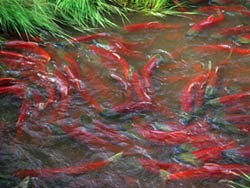
Sockeye salmon - Oncorynchus nerka Identification: 
Spawning: Young fry stay in the rivers from one to three years before heading to sea. They then spend about four years at sea before returning to their native lakes and tributaries to spawn. Lake Ozette and Lake Crescent both have populations of "landlocked" sockeye called Kokanee. They spend their entire lives in the lake and are smaller than the anadromous version of sockeye. Lake Crescent's population of Kokanee is thought to have become landlocked when Lake Crescent was separated from Lake Sutherland by a massive landslide about 7,000 years ago. Lake Sutherland drains into the Elwha River, which, in the past, had sockeye returns before the construction of the Elwha dam. (Historic Range Map) Conservation Status: The anadromous stock of sockeye in Lake Ozette Lake is listed as threatened under the Endanged Species Act. The National Oceanic and Atmospheric Administration (NOAA) adopted a final recovery plan in May 2009. Sockeye in the Elwha River are basically extinct. When the dams are removed, it is anticipated that the Lake Sutherland Kokanee population will contribute to the natural restoration of sockeye. It is unknown as to how rapidly sockeye will recover; projections have been made which hope to restore the population to around 3,000 spawners in the two decades following dam removal. External links: To learn more about recovery efforts for Lake Ozette sockeye, take a look at these additional sites: NOAA's Lake Ozette sockeye recovery page Washington Coast Sustainable Salmon Partnership website The West End Natural Resources News (a publication of the North Pacific Coast (NPC) Marine Resources Committee and the NPC Lead Entity for Salmon Recovery) |
Last updated: April 24, 2025

